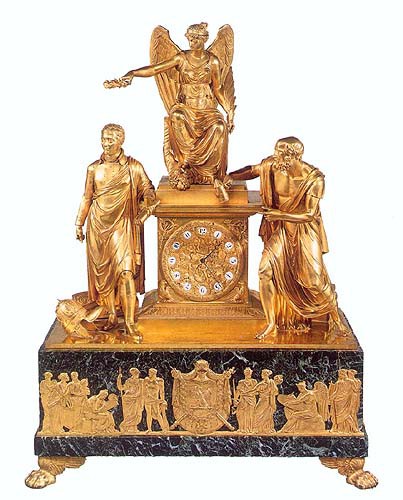At the end of the 18th and beginning of the 19th centuries, the 'Exposition des produits de l'Industrie française' (Exhibition of the produce of French industry), which provided a showcase for best objects produced by each department, played a key role in the relaunching of the French economy. During the Empire period, the most sumptuous of these Expositions was that of 1806, held in the area between the Hôtel des Invalides and the river Seine. The bronzesmith Claude Galle (1759-1815) exhibited there several of his clocks, including one entitled: 'Diogenes looking for a man'. The theme, the idea for which came from a certain Provost, met with great success.
The scene comes from the famous anecdote taken from the life of Diogenes of Sinope 'the Cynic', a cynic philosopher of the 4th Century B.C., famed for his caustic wit, his dislike of riches and convention, and his existence completely devoid of superfluity. Walking around Athens at midday with a lantern (in some versions this a a candle) in his hand, Diogenes replied to those who asked him what he was doing: 'I am looking for a man'. In this composition, it seems that he has found one, in the form of Napoleon! The philosopher's pose, the index finger raised, all movement suspended, the lantern swinging, everything emphasises the philosopher's stupefaction.
The anecdote provides the pretext for a celebration of the emperor. In his calm and simple pose, Napoleon is represented as a hero of antiquity. Crowned with a laurel wreath by Victory and draped in a toga, he holds a page of the Code Civil in his left hand (a reference to his work as legislator), whilst the helmet and shield at his feet are evocations of his great military deeds. This glorification is continued on the marble pedestal. On either side of the great imperial coat of arms, the union of the French Empire with the Kingdom of Italy is symbolised by the allegorical figures of the Seine and the Tiber. Finally, at the very edge, Fame and History, write the exploits of the great man on their tablets.
Napoleon however did not like allegories. It was no doubt for this reason that despite Galle being the supplier of a number of objets d'art for the imperial palaces, the clock here was not acquired by the 'Garde-Meuble de la Couronne' (Crown furniture department). It disappeared for more than a century before reappearing at an antique dealer who in 1938 sold it to the Musée de Malmaison.
Karine Huguenaud (tr. P.H.)
April 2002
Clock: "Diogenes looking for a man"
Artist(s) : GALLE Claude


